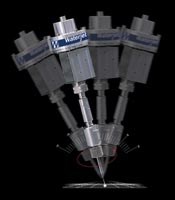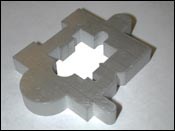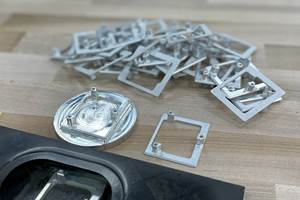A Highly Complementary Combo
Wire EDM and abrasive waterjet go together well, especially for cutting aluminum.
Wire EDM and abrasive waterjet (AWJ) are increasingly seen as highly complementary processes. The combination takes advantage of the speed of AWJ and the high accuracy of wire EDM. AWJ is used for rough cutting and wire EDM is used for finish cutting to tight tolerances and very fine surface finishes. The result can be a significant reduction in overall production time.
One of the most promising applications for this combination is cutting aluminum because the advantage of roughing with AWJ and skim cutting with wire EDM are particularly strong for this material. Complex, close-tolerance aluminum components are proliferating in many key industries such as electronics, aerospace and defense. OEMs are looking for shops that can make these parts quickly and economically, and production strategies that use wire EDM and AWJ to reduce the number of process steps and to streamline individual steps are bound to be winners. Advances in the latest generation of waterjet equipment further enhance this effect.
To get a glimpse of how the combo of wire EDM and AWJ can improve productively with wire EDM, we asked MC Machinery Systems Inc. (Wood Dale, Illinois) to examine and discuss a sample study part, shown above. MC Machinery Systems is the North American source for wire and ram EDM technologies from Mitsubishi EDM and the line of AWJ machines branded as Waterjet Powered by Mitsubishi Electric. The same part was produced entirely on a wire EDM and then again on an AWJ machine. The table on the next page compares the two processes and summarizes the results.
The sample part is half-inch thick 6061 aluminum. The part’s outside dimensions measure 2.5 by 3.0 inches. The inside shape is a scaled-down version of the outside contour with 0.020-inch inside radii. The outside radii are sharp.
The EDM test cut was performed on a Mitsubishi FA10S using 0.010 brass wire. The machine’s travels are 10 by 14 by 8.6 inches. To replicate results that the typical user could expect in the field under normal operating conditions, machining parameters were derived from the set of standard technology settings resident in the control software. The achievable surface finish is 50 microinch Ra in aluminum with four skim cuts. Two start holes were needed, one for the inside and one for the outside shapes. A similar test was performed in steel, achieving 10 microinch Ra with the appropriate technology.
The AWJ test cut was performed on a Suprema 1200 Waterjet Powered by Mitsubishi Electric. The machine travels are 48 by 48 inches with 6-inch cutting height in Z. This model is equipped with a 60-hp waterjet pump designed to create as much as 60,000 psi of cutting pressure. The Suprema also has a standard feature called Intelligent Tapering Control (ITC) that allows faster cutting while maintaining side wall straightness. Similar to the wire EDM test cut, this test cut used machining parameters that would be applied in a typical user application.
At first glance, it might seem that the speed of the AWJ for roughing in this case is the whole story. However, according to Steve Szczesniak, national waterjet product manager for MC Machinery Systems, there is more to it than that. For one thing, he says, AWJ has benefits that may help shops overcome reluctance to wirecut aluminum. For another, not all rough cuts with AWJ are the same. Users can select the parameters that help them optimize the results in conjunction with wire EDM skim cuts.
| Wire EDM And AWJ Test Cuts Material: ½-inch thick aluminum. Total length of cut is about 16 inches. |
||
| EDM Cut Information | Cut Time | Surface Finish |
| Rough Cut | 24.24 minutes | 190 µ inch Ra |
| Skim 1 | 25.4 minutes | 90 µ inch Ra |
| Skim 2 | 24.24 minutes | 82 µ inch Ra |
| Skim 3 | 26.22 minutes | 58 µ inch Ra |
| Skim 4 | 28.57 minutes | 50 µ inch Ra |
| Total Cut Time | 2 hours 8 minutes | |
| Abrasive Waterjet Cut Information | Cut Time | Surface Finish |
| 60,000 psi with 120-mesh abrasive | 6.4 minutes | 85 µ inch Ra |
| The results of the test cuts show a significant reduction in rough cutting time with AWJ. In this case, a 73-percent time savings was achieved with AWJ, not counting time saved because no start holes were needed. | ||
The Trouble With Aluminum
Because cutting aluminum with wire EDM has some undesirable drawbacks, some shops try to avoid the process, especially if they also wirecut steel or graphite. One problem with wirecutting aluminum is the large volume of debris particles created during the process. It can quickly clog an EDM filtration system.These particles are an unavoidable by-product of EDM, which is a thermal process. In a sequence that occurs thousands of times a second, EDM uses the extremely high temperature created by the flow of electrical current in each “spark” to form a microscopic bubble of vaporized material just below the workpiece surface. When this bubble expands and bursts, it expels molten bits of the parent workpiece material into the dielectric fluid, where they solidify. The particles created by wirecutting aluminum are very small and very hard. They shorten the life of certain types of filter media and cause the filter cartridges to be changed more often. Disposal of filters containing these particles is costly, and they are not easily recycled. In addition, if these particles remain in the wire EDM dielectric system, they can interfere with the wire cutting of other materials or contaminate the workpiece surfaces.
Because rough cutting a part from a solid blank with EDM removes considerably more material than subsequent skim cuts, finding an alternative process for this step is very attractive. Laser cutting is a possibility, but cutting aluminum in thicknesses greater than ½ inch is difficult. Laser cutting also creates a heat-affected zone that is not easily removed with skim cutting on a wire EDM unit.
Why Rough Cut With AWJ?
AWJ does not face these difficulties. AWJ uses a high-pressure stream of water containing an abrasive grit (usually pulverized garnet) that aggressively wears away the workpiece material as it blasts across the surface. AWJ does not heat or distort the material it is cutting. Chunks of material cut away by AWJ are perfectly suitable to be used for other jobs. Also, AWJ does not need a start hole—it can create its own by piercing the material directly.However, cutting with a high-pressure steam of water differs in several critical ways from cutting with an energized wire as EDM does. The cutting action of AWJ changes with distance from the nozzle, whereas the cutting action of the wire is virtually the same throughout the full length of its engagement (assuming that flushing conditions are uniform.) With AWJ, the stream begins to lose pressure and spread out as it leaves the orifice. It also deflects away from the direction of travel as a function of axis travel speed. All of these factors degrade the accuracy and surface finish, and the effects are more noticeable depending on the height of the cut.
Overcoming “Jet Lag”
Recent developments in waterjet technology are able to provide considerable compensation for these natural tendencies in the cutting action of AWJ. For example, the intelligent tapering control system on the Suprema model used in the test cut tilts the high-pressure waterjet as much ±6 degrees to correct for the spread of the stream. This system hinges on the machine’s four-axis configuration. According to Mr. Szczesniak, this feature allows faster cutting speeds in a contour and is the key to moving directly to skimcutting.The company’s five-axis Evolution 3D System includes a further refinement that enhances AWJ results. This system uses a self-positioning device that references a rotation point on the surface of the workpiece near the cutting nozzle, thereby maintaining a constant distance between the surface and the nozzle when following 3D geometry.
These developments help AWJ create a smoother, straighter and more consistent surface that may require fewer skim cuts to achieve the desired accuracy and surface finish.
Additional Cutting Tips
Mr. Szczesniak has the following recommendations for maximizing the value of rough cutting with AWJ as a prelude to wire EDM:- Use the correct nozzle and orifice for the geometry detail required. This will allow you to rough out as much detail as possible during the waterjet cutting process and avoid re-roughing on the EDM. The smaller the orifice size, the smaller the attainable radius. However, cutting speeds have to be decreased accordingly.
- Wall straightness affects the number of skimcuts needed on the wire EDM. Taper control is necessary to cut parts as straight as possible on a waterjet. It also minimizes total cut time.
- The finer the abrasive used in AWJ, the finer the finish achievable with the process. However, finer abrasives cut less aggressively and increase cutting time proportionately. In most cases, the best strategy is to use the finest abrasive on the waterjet and the least number of skimcuts on the EDM.
Related Content
When a Lathe With Live Tooling Rivals a Multitasking Machine
This shop is working its way up to a full-fledged B-axis multitasking machine. Meanwhile, turning centers with a Y-axis and live tooling are doing just fine.
Read More10 Things to Know About Creep-Feed Grinding
Because of the high material removal rate creep-feed grinding can deliver in challenging materials, grinding might not be just the last step in the process—it might be the process.
Read MoreHow to Turn Machine Shop Downtime Into Process Expertise
To take advantage of a lull in business, JR Machine devised a week-long cutting tool event that elevated the shop’s capabilities with aerospace alloys.
Read MoreMachine Monitoring Boosts Aerospace Manufacturer's Utilization
Once it had a bird’s eye view of various data points across its shops, this aerospace manufacturer raised its utilization by 27% in nine months.
Read MoreRead Next
The Cut Scene: The Finer Details of Large-Format Machining
Small details and features can have an outsized impact on large parts, such as Barbco’s collapsible utility drill head.
Read More3 Mistakes That Cause CNC Programs to Fail
Despite enhancements to manufacturing technology, there are still issues today that can cause programs to fail. These failures can cause lost time, scrapped parts, damaged machines and even injured operators.
Read More













.png;maxWidth=300;quality=90)







.png;maxWidth=300;quality=90)











